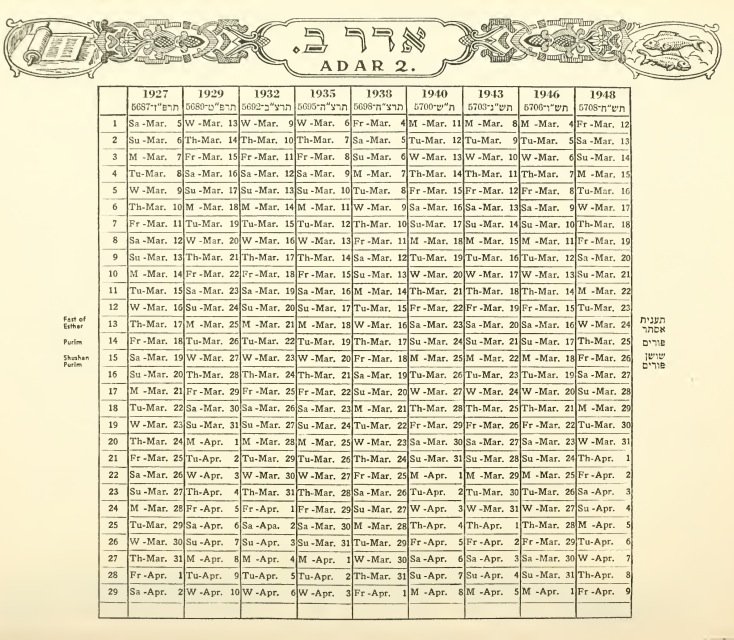In approaching this study, we must first understand that two different calendars were in use in the kingdoms (and the Julian Calendar - precursor to Gregorian - would have to wait a few centuries). In Judah they observed the civil New Year which commenced in the fall, on the first day of the seventh month, Tishri, with the feast of Trumpets (the Day of the Sounding of the Shofar, Numbers 10:1-10), or Rosh Hashanah.[1] This holiday commenced a month of feasting and celebration, including Yom Kippur and the Feast of Tabernacles.
In Israel, the New Year commenced in the spring on the first of Nisan, the first month of the Jewish religious calendar. Therefore, our current calendar year intersects with two years of both calendars of the divided kingdom, which necessitates that each of their years, in turn, intersects with two different years of their counterpart’s calendar, adding to the challenge before us.

Wikimedia
Do We Count Accession-Years?
The difference between an accession-year (succession-year) and a non-accession-year (non-succession-year) must be noted as well. Depending upon the kingdom and the time period, sometimes the year of succession would be counted in the reign of the king, and sometimes it would not. In the accession-year reckoning the year of accession is not counted as part of the reign. In the non-accession-year reckoning the first year is counted as a full year of the king’s reign, regardless of how long he reigned during that year.

Wikimedia
In Israel, from the reign of Jeroboam to Jehoahaz the non-accession-year reckoning was used, and from Jehoash to Hoshea the accession-year reckoning was used.[2] This, combined with the differing calendar years, adds even more of a challenge to us as we attempt to discern the true chronology of the ancient rulers of Judah and Israel.
What About Co-regencies?
The accession challenge is further compounded by the fact that there are many instances of co-regency. This brings us many challenges, which are laid out well by Nadav Na’aman:
- Does the age of a king when he ascended the throne point to his commencement of coregency, or to the beginning of his sole reign?
- [Do] the years counted for a king designate his sole rule exclusive of co-regency, or rather his entire term of kingship including the years overlapping with those of his father?
- Does the synchronism for the accession refer to the beginning of the co-regency, or to the commencement of his sole reign?
- Are the years of the neighbouring king in this synchronism counted from the commencement of his co-regency, or from the start of his sole reign?[3]
Na’aman goes on to give more detail and examples of how this happened in the ancient Egypt. “The comparative data of the Egyptian sources exemplify the complicated nature of the records relating to the overlapping years.”[4] The final comments of his article bear repeating:
When taking into account the permanent nature of the co-regency in Judah from the time of Joash, one may dare to conclude that dating the co-regencies accurately is indeed the key for solving the problems of biblical chronology in the eighty century B.C.[5]
Leslie Mc Fall shows remarkable consistency in how this may have been done in his excellent article on this topic.[6] His chart reveals extensive research and is included in the articles referenced, as well as his personal web site[7].
With these considerations on the table, tomorrow we'll take our first stab at a working calendar. It'll be fairly short too, since I'm trying to keep the study in manageable pieces that focus on specific aspects. Part 4 will be fairly long though, so enjoy the brevity while you can.
Steemin' on,
Another Joe

Email notifications
AJ Facebook
AJ Twitter
[1] Bruce Scott, The Feasts of Israel: Seasons of the Messiah (Bellmawr, N.J.: Friends of Israel Gospel Ministry, 1997), 77.
[2] Edwin R. Thiele, A Chronology of the Hebrew Kings (Grand Rapids, Mich.: Zondervan Corporation, 1977), 18-19.
[3] Nadav Na’aman, “Historical and Chronological notes on the Kingdoms of Israel and Judah in the Eighth Century B.C.,” Vetus Testamentum 36/1 (1986): 85.
[4] Ibid., 87.
[5] Ibid., 91.
[6] Leslie McFall, “A Translation Guide to the Chronological Data in Kings and Chronicles,” Bibliotheca Sacra 148/589, (January 1991): 3-46.
[7] https://lmf12.files.wordpress.com/2012/11/hebrew_revised_kings.pdf
[NOTE: It saddens me to report that Leslie McFall passed away last year. Several years ago I was blessed with sharing my research and interacting with him online. He was incredibly gracious, not only responding but offering further insights. Not wanting to take up too much of his time, I kept my interaction brief. But, even a decade later, his kindness left an impression on me that struck me as I found out about his passing.]
~ Introduction - Part 1 ~


In my limited researches I have noted that there are these challenges to harmonising calendars, but have never found such a clear explanation. Thank you. And a generous tribute to Leslie McFall. Looking forward to next edition.
These are the types of things that get out of control and make my head hurt after awhile. Sometimes when I am in deep research for a post there is a bunch of stuff I am tracking and I am trying to reconcile some dates to events and whatnot, gets confusing.
I can already see why some people spend their lives on it.
When getting into this sort of study, I kinda get into a zone and can go many hours without stopping. Initially I prepared preliminary reading and resources for this study for a couple of months, then dove in when I had a break. It ended up being an intense three days of doing nothing else - incredibly exhilarating and fatiguing at the same time.